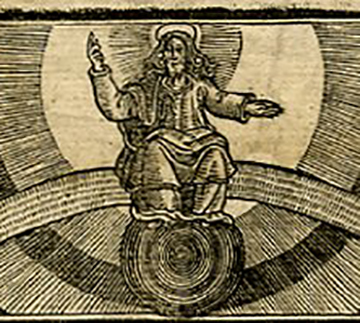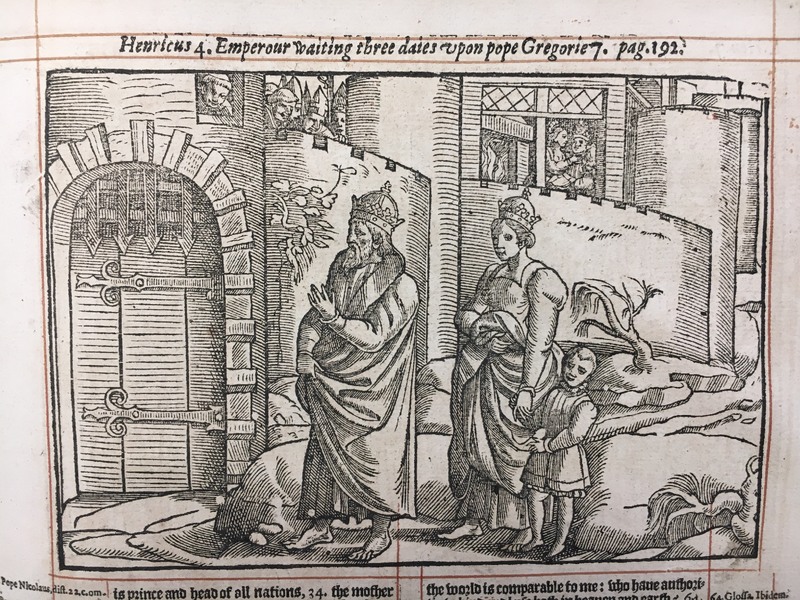Emperor Henry IV and his Child
How do we know that this child is Conrad II? After looking at the dates of birth for all of Emperor Henry IV’s children, Conrad is the only one who would have been a young child in the winter of 1077. Emperor Henry’s other son, Henry, lived just until his first birthday, while his youngest son, Henry V, was not born until 1081. Thus Conrad, having been born in 1074, is the only logical option. Having established that Conrad is the young child in the woodcut, it is worth questioning how his young age is represented. If he is indeed only three years old, why is he dressed as an adult?
Moreover, why is he dressed as a young courtier? Mateo Felice’s 1465-70 David with Musicians and Dancing Children comes nearly four hundred years after the time Conrad and his father were supposed to be in Cassona, yet the long tunics sported by the adult-like children is closer to how Henry and Conrad would have been historically dressed. Indeed, in the woodcut image Conrad sports an early modern coat and collar.
What is the function of having Conrad wearing the styles of the age in the 1610 edition of Acts and Monuments? I suggest that this is so historical players can be repurposed for the present day. Readers would be more likely to identify with historical players that looked like them and dressed like them, thus having Conrad in early modern clothing positions him as culturally and historically relevant for readers in the early seventeenth century.
However, what about the readers that would not identify with clothing that is decidedly upper-class? Although lower-class readers might not identify with Conrad, perhaps they could aspire to be more like him. While it is unclear whether children would have been seeking to ascend the social ladder, they would certainly have been encouraged to better their moral character. Thus Conrad is functioning not so much as a social ideal but as a moral one.
Other woodcuts in Foxe’s Acts and Monuments show Conrad alongside his father and mother. In the woodcut below, Emperor Henry IV is forced to surrender his crown to Pope Gregory VII. In this picture, Conrad is constructed as a small adult rather than as a child. For example, his features are more pronounced and his posture is stiff rather than relaxed. Moreover, Conrad's innocence seems to be violated by the advent of his father surrendering his power to Pope Gregory.
Conrad is also depicted as mirroring his father’s body language, further constructing him as a young adult. Interestingly, Conrad seems to be almost caricaturized: the viewer's eye is drawn directly to him and the perceived horror of passing imperial power to the Catholic papacy is effectively highlighted.
While it might be a stretch, I propose that constructing Conrad as aghast provides a “road map” for how child readers should feel when they look at the woodcut images. Thus while the majority of child readers would never be the son of an Emperor, they could mimic Conrad’s moral outrage at the increase of papal powers.
However, were children actually reading Foxe?
In the Introduction to Warren Wooden’s text Children’s Literature of the English Renaissance, Jeanie Watson argues that Foxe’s Acts and Monuments would have been impossible for the Renaissance child to avoid: the text was “chained […] to Protestant pulpits for generations and [was] later abridge to make it accessible for the ordinary home library” (Watson xvi). Indeed, in his text Wooden suggests that the text was placed in the hands of Protestant children in England for nearly three centuries: “[t]he original Renaissance editions, massive black folios, were expensive, but, my government decree, chained in cathedral and many parish churches and laid out in the anterooms an ecclesiastic, they were as readily accessible to children as to their elders” (Wooden 73).
Indeed, Wooden notes that while the first two editions of the work which became the Book of Martyrs, the great Actes and Monuments of These Latter and Perillous Dayes…(1563) was produced in the vulgar tongue for the explicit benefit of “the simple flock of Christ, especially the unlearned sort, so miserably abused.” (Wooden 74). Moreover, Wooden notes that Foxe rejected the style of the tract or sermon for narrative and description of heroic and tragic action (74). Further, Acts and Monuments is indeed replete with lavish woodcuts – Wooden suggests that these may be based on his own original sketches – that coordinate with the text (75). While marginalia is not the focus of my exhibit, Wooden suggests that the running scholia represents another attempt by Foxe to extend the range and appeal of his book to every audience (75).
A final technique utilized by Foxe is the repetition of words actions and ideas (76). Because the Elizabethan editions ran over two thousand folio pages, it is unlikely that anyone ever sat down and read Acts and Monuments straight through (76). Within this circumstance in mind, Foxe focussed on the key issues that divided Roman Catholicism from Protestantism: for example, the nature of the Eucharist, and the roles of the priesthood and the Bishop of Rome (76). Wooden astutely notes that repetition within the text is a key technique for Foxe, as it enables him to connect the suffering and sacrifice of sixteenth-century Protestants with those of dissenters and reformers through the Middle Ages, back to the Roman arenas, and finally to the apostles themselves (77).




